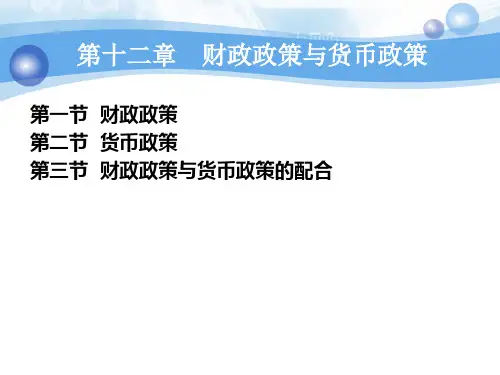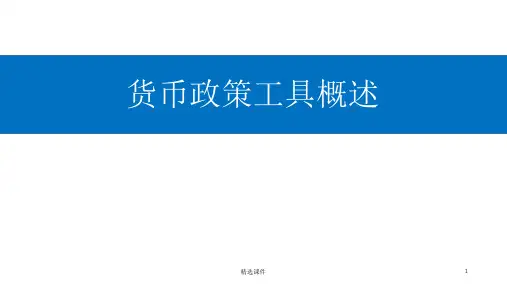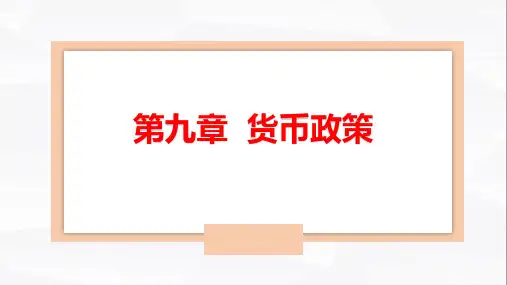货币政策工具ppt课件
- 格式:ppt
- 大小:545.50 KB
- 文档页数:30






FinanceChapter4 Central Banking and the Conduct of Monetary PolicyCentral BanksThe Money Supply ProcessTools of Monetary PolicyLecture 10Tools of Monetary Policy•Goals of Monetary Policy and Conventional Monetary Policy Tools•The Market for Reserves and the Federal Funds Rate •How Tools of Monetary Policy Affect the Federal Funds Rate •Advantages and Disadvantages of Conventional Monetary Policy ToolsLearning ObjectivesSummarize how conventional monetary policy tools are implemented and the relative advantages and limitations of each toolIllustrate the market for reserves, and demonstrate how changes in monetary policy can affect the equilibrium federal funds rate.Part 1Goals of Monetary Policy and Conventional Monetary Policy Tools1.1 Goals of Monetary Policy•Price stability (*)•High Employment•Economic Growth•Stability of Financial Markets •Interest-Rate Stability•Stability in Foreign Exchange Markets1.2 Monetary Policy ToolsMonetary policy tools are the instruments used by the central bank to regulate the money supply and interest rates in order to achieve the goal of monetary policy.Conventional monetary policy tools :•Open market operations•Discount lending•Reserve requirementsNonconventional Monetary Policy Tools:Quantitative Easing, Credit Easing, Liquidity Provision, Large-Scale Asset Purchases, Forward Guidance and the Commitment to Future Policy ActionsPart 2The Market for Reserves and the Federal Funds Rate2.1 Goals of the Fed's Monetary PolicyThe goals of the Fed's monetary policy:According to the Federal Reserve Act, the goal of U.S. monetary policy is to control inflation and promote full employment.Intermediate goals of the Fed's monetary policy:The Fed uses the federal funds rate as the main monetary policy monitoring indicator and manipulation target.2.2 The Market for Reserves and the Federal Funds Rate•Demand CurveRR dd= Required reserves + Excess reservesThe trend of demand curve:As the federal funds rate ii ffff decreases, other things being equal, the opportunity cost of holding excess reserves decreases and the demand for excess reserves increases——the demand curve is downward sloping——but the process is not over.2.2 The Market for Reserves and the Federal Funds Rate•Demand CurveThe trend of demand curve:Since 2008, the Fed has paid interest on reserves at a level that is typically set at a fixed amount below the federal funds rate target.Suppose the interest rate paid on reserves is ii oooo, when federal funds rate ii ffff begins to fall below ii oooo, banks do not lend in the overnight market at a lower interest rate. Instead, they just keep on adding to their holdings of excess reserves indefinitely——the demand curve becomes flat (infinitely elastic)2.2 The Market for Reserves and the Federal Funds Rate2.2 The Market for Reserves and the Federal Funds Rate•Supply CurveRR ss= Nonborrowed reserves (NBR)+ borrowed reserves (BR) NBR: Amount of reserves that are supplied by the Fed’s open market operations. BR: Amount of reserves borrowed from the Fed, the interest rate charged by the Fed on these loans is the discount rate,ii dd, which is set at a fixed amount above the federal funds target rate.2.2 The Market for Reserves and the Federal Funds Rate•Supply CurveThe trend of supply curve:Borrowing federal funds from other banks is a substitute for borrowing (taking out discount loans) from the Fed.When ii ffff< ii dd,banks will not borrow from the Fed because borrowing in the federal funds market is cheaper, so BR=0, R s= NBR. And so the supply curve will be vertical. When ii ffff> ii dd, banks will want to keep borrowing more and more at ii dd and then lending out the proceeds in the federal funds market at the higher rate, ii ffff. The supply curve becomes flat (infinitely elastic) at ii dd.2.2 The Market for Reserves and the Federal Funds Rate2.2 The Market for Reserves and the Federal Funds Rate•Market EquilibriumMarket equilibrium occurs when the quantity of reserves demanded equals the quantity supplied, RR dd=RR ssEquilibrium therefore occurs at the intersection of the demand curve RR dd and the supply curve RR ss, with an equilibrium federal funds rate of ii ffff∗When ii ffff>ii ffff∗, more reserves are supplied than are demanded (excess supply). When ii ffff<ii ffff∗, more reserves are demanded than are supplied (excess demand).2.2 The Market for Reserves and the Federal Funds Rateii dd>ii ffff>ii ooooPart 3How Tools of Monetary Policy Affect the Federal Funds RateOpen market purchase leads to greater quantity of reserves supplied, which increases nonborrowed reserves.Open market sale leads to less quantity of reserves supplied, which decreases nonborrowed reservesThe effect of an open market operation depends on whether the supply curve initially intersects the demand curve in its downward-sloped section or in its flat section.If the intersection initially occurs on the downward-sloped section of the demand curve, an open market purchase causes the federal funds rate to fall, whereas an open market sale causes the federal funds rate to rise. (typical situation)If the supply curve initially intersects the demand curve on its flat section, open market operations have no effect on the federal funds rate, because the interest rate paid on reserves, ii oooo, sets a floor for the federal funds rateThe effect of a discount rate change depends on whether the demand curve intersects the supply curve in its vertical section or its flat section.If the intersection occurs on the vertical section of the supply curve, there is no discount lending and borrowed reserves (BR=0). When the discount rate (ii dd) is lowered by the Fed, no change occurs in the equilibrium federal fundsrate. (typical situation)If the demand curve intersects the supply curve on its flat section, there is some discount lending (BR>0). When the discount rate (ii dd) is lowered by the Fed, the equilibrium federal funds rate falls, and BR increases.When the required reserve ratio increases, required reserves increase and hence the quantity of reserves demanded increases for any given interest rate.When the Fed raises reserve requirements, the federal funds rate rises.When the Fed decreases reserve requirements, the federal funds rate fallsMonetary PolicyTools How to Affect Money Supply and ii ffffOpen Market Operations•Affect Money Supply: Open Market Purchase → MB↑→M↑•Affect ii ffff : a) Open Market Purchase → ii ffff ↓ (Usually)b) Open Market Purchase → ii ffff remains unchangedDiscount Lending •Affect Money Supply: a) Discount rate change → M is unchanged (Usually)b) Discount rate ↓ → M↑•Affect ii ffff : a) Discount rate change →ii ffff remains unchanged (Usually)b) Discount rate ↓ → ii ffff ↓Reserve Requirements•Affect Money Supply: rr ↑→M↓•Affect ii ffff : rr ↑→ii ffff ↑3.4 Summary3. How Monetary Policy Tools Affect ii ffffPart 4Advantages and Disadvantages of Conventional Monetary Policy ToolsMonetaryPolicy ToolsAdvantages DisadvantagesOpen Market Operations •The initiative lies with the centralbank•Flexible and precise•Can be executed quicklyMust be based on well-developed financialmarkets, i.e. there must be a sufficient variety andnumber of securitiesDiscount Lending •Central bank can act as the lenderof last resort•Central banks can realize theirpolicy intentions by increasing ordecreasing the discount rate•Central banks can only affect discount rate,but cannot command banks to borrow•When ii dd remains unchanged, changes in ii ffffmay change discount loans and money supply.•Central bank's changes in the discount ratemay be misinterpreted by the market.MonetaryPolicy ToolsAdvantages DisadvantagesReserve Requirements •The initiative lies with the central bank•Can have a rapid, powerful and widespreadimpact on the money supply•Acts on all banks or depository financialinstitutions, and is objective and fair to allfinancial institutions.•Can reflect the policy intention of the centralbank.•The effect on the money supplyis too violent and lack ofelasticity;•The expected effect of thepolicy is largely limited by theamount of excess reserves in thebanking system.SummaryT H A N K S。

